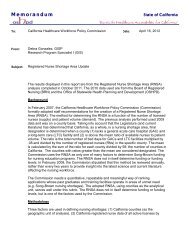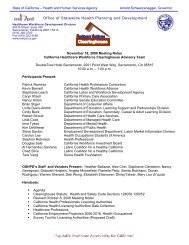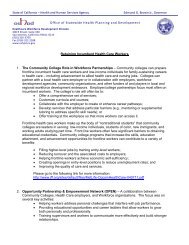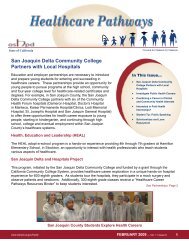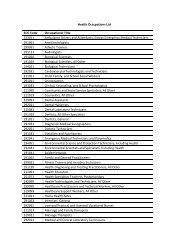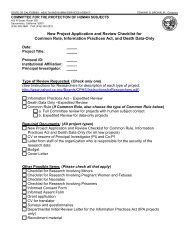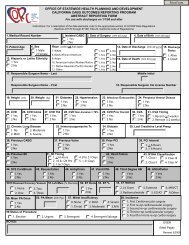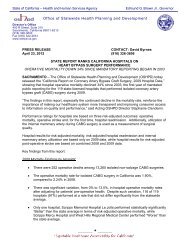Best Practices for Project Management, Design, and Construction of ...
Best Practices for Project Management, Design, and Construction of ...
Best Practices for Project Management, Design, and Construction of ...
Create successful ePaper yourself
Turn your PDF publications into a flip-book with our unique Google optimized e-Paper software.
project <strong>and</strong> its potential impact. A draft EIR (DEIR) is prepared <strong>and</strong> published with a comment<br />
period deemed long enough by the local jurisdiction to ensure all concerned persons <strong>and</strong><br />
organizations have a chance to comment. Comments <strong>and</strong> their responses are published in a final<br />
EIR (FEIR), the findings <strong>of</strong> which must be approved by the local jurisdiction along with any<br />
modifications to urban plans <strong>and</strong> a development agreement (if required). Because this is a<br />
discretionary l<strong>and</strong> use issue, there is no guarantee that a proposed project will be approved to<br />
proceed to construction. Once approved, the local jurisdiction issues a Notice <strong>of</strong> Determination<br />
(NOD) which serves as the pro<strong>of</strong> <strong>of</strong> entitlement to be provided to OSHPD <strong>and</strong> other permitting<br />
entities. The NOD is required by the local building department to release local permits as well.<br />
Other Permitting Entities<br />
Many locations in Cali<strong>for</strong>nia have multiple layers <strong>of</strong> government which may have permitting<br />
authority. Most common are local air quality management districts that issue asbestos abatement<br />
<strong>and</strong> emergency generator permits. The local planning department or your legal counsel should<br />
assist you in determining which additional government bodies have influence over your project.<br />
Cali<strong>for</strong>nia Department <strong>of</strong> Public Health (CDPH)<br />
Prior to commencement <strong>of</strong> operation <strong>of</strong> your new or remodeled facility, CDPH will survey the<br />
facility <strong>and</strong> its operational practice <strong>and</strong> readiness following field acceptance by OSHPD field staff.<br />
While this is fundamentally a step undertaken at project closeout, it is essential that the hospital<br />
have a plan in place during the project planning phase to ensure that the survey will be<br />
successful. Any service that the hospital intends to <strong>of</strong>fer in a new or innovative way should be<br />
reviewed with the local CDPH <strong>of</strong>fice prior to design to reduce the likelihood <strong>of</strong> rejection following<br />
completion <strong>of</strong> construction.<br />
<strong>Best</strong> Practice 6: Determine your project scope <strong>and</strong> phasing<br />
Use your staff <strong>and</strong> consultants to fully define all <strong>of</strong> the project’s characteristics. Underst<strong>and</strong> the<br />
type <strong>of</strong> approval required <strong>and</strong> the documentation needed <strong>for</strong> review. This is a more detailed<br />
function than <strong>Best</strong> Practice 1 <strong>and</strong> is a necessary precursor to <strong>Best</strong> Practice 7. Adding, deleting, or<br />
changing services to be included in the project will add cost <strong>and</strong> time.<br />
<strong>Best</strong> Practice 6a: Select the project approach <strong>and</strong> organization that is appropriate <strong>for</strong> the<br />
nature <strong>of</strong> the project <strong>and</strong> the hospital’s preferred construction contracting method<br />
Owners should keep control <strong>of</strong> the construction process throughout the length <strong>of</strong> the project. The<br />
manner in which the work is contracted should reflect the nature <strong>of</strong> the work <strong>and</strong> business<br />
approach <strong>of</strong> the owner. There are three fundamental contracting modes, with ample variation<br />
between them. Select the one that’s right <strong>for</strong> you.<br />
<strong>Design</strong>-Bid-Build<br />
Considered the traditional model <strong>of</strong> construction contracting, the design-bid-build model relies on<br />
designers who develop plans that are intended to guide the work <strong>of</strong> the contractor. The<br />
“design-intent” documents are less than complete, leaving many design decisions up to the<br />
bidding contractor to give them as much flexibility to determine means <strong>and</strong> methods <strong>and</strong><br />
ultimately the bid price. Long thought to be the method that assures lowest cost, many owners<br />
(OSHPD <strong>Best</strong> <strong>Practices</strong>) Page 92 DRAFT FINAL, Sept. 2011



